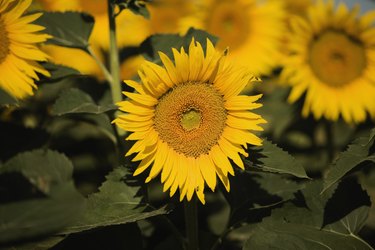
You can preserve whole sunflowers of any size by using a number of methods, depending on whether you want to make them last longer while fresh or dried. Floral preservative keeps sunflowers looking their best for fresh flower projects, while air-drying and desiccant preserve sunflowers for dried arrangements and other decorative craft projects. Dried sunflowers keep their color well unless they are exposed to direct sunlight. Keep dry sunflowers away from heat and flame, and keep bleach and desiccant out of the reach of children.
Choose the Flowers
Video of the Day

Select sunflowers that are just beginning to open as well as sunflowers with their petals partly extended. For fresh flowers to put in a vase of water, cut the sunflowers first thing in the morning and put them in water immediately. To dry them, pick the sunflowers in the afternoon when they have the least amount of water in them, and don't put them in water. Avoid using sunflowers that have been in full bloom for more than a day or two. Older flowers deteriorate faster. Mature dried sunflowers might also attract rodents and insects because of their tasty seeds.
Video of the Day
Cut the Stems
Cut the flowers with hand clippers or a sharp knife. For large sunflowers to arrange in tall vases, cut at least 2 feet of stem for good proportion. For garlands, headbands and small craft projects, 1 foot of stem is enough to hang the sunflowers to dry. If you plan to dry them in dessicant, leave only a 1-inch stem. Because of their bulk, sunflowers aren't good candidates for pressing.
Extend Their Vase Life
Sunflowers last longer in water if you seal the stems, and it takes only 20 seconds of high heat to do so. Dip the stems ends in a pan of boiling water or hold each cut end to a candle flame. This keeps the sunflowers from losing their sap in the water and preserves their vitality. Use floral preservative in the vase water or make your own. Add a dash of household bleach to equal parts water and a soft drink. Use a soda that contains sugar, not artificial sweetener. Keep the sunflowers in a cool spot and change their water daily to prolong their vase life.
Air-Dry the Blooms
To air-dry sunflowers, cut off all the leaves. Hold three or four with the flower heads staggered at different heights so they aren't touching, and put a rubber band or cord around the stems. Put an S-hook through the rubber band or tie a loop in the cord to hang them from a nail, clothes hangers or clothesline in a cool, dry place. Air circulation helps them dry, so choose a roomy area such as a garage or storeroom over a crowded closet. It isn't necessary to dry sunflowers in the dark. If the sun is shining brightly in your drying area, put paper bags over the flower heads to prevent fading. Hanging them upside-down reduces dust on the flower faces. Hang very large sunflowers individually. Drying time varies by climate, the humidity in the room, and the size and variety of sunflower.
Use Silica or the Microwave
Layer sunflower heads in coffee or cookie tins with silica gel, a desiccant sold at hardware stores and garden centers. Pour 2 inches of silica in the bottom of the container; set a sunflower on the dessicant face-up; and gently pour in at least an inch of silica gel, moving from the outsides of the container to the center. Repeat the process for as many sunflowers as the container will hold, allowing for an inch of dessicant on the top flower. It takes about a week to dry them, but this method gives the best color-retention. Mexican sunflowers, also called Tithonia, dry in 5 to 6 minutes in a microwave oven. Leave them standing in a container for 10 minutes after microwaving. These flowers have compact flower heads; bulkier sunflower varieties aren't good candidates for microwave drying.
- National Gardening Association: How-To Project: Preserving Cut Flowers
- Old Farmer's Almanac: Sunflowers
- University of Kentucky: Preserving Flowers and Foliage
- Georgia Department of Agriculture: Tithonia, the Mexican Sunflower
- Fine Gardening: Sunflowers -- Helianthus
- PBS: The Victory Garden: Grow: Primers and Projects -- Dried-Flower Power